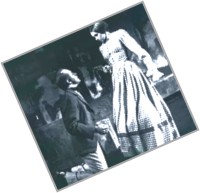|
Classic Corner
Crime and Punishment
By Fyodor Dostoevsky
 Crime and Punishment is a novel written by Russian author Fyodor Dostoevsky. First published in a journal named The Russian Messenger, it appeared in twelve monthly installments in 1866, and was later published as a novel. Along with Leo Tolstoy's War and Peace, the novel is considered one of the best-known and most influential Russian novels of all time. Crime and Punishment is a novel written by Russian author Fyodor Dostoevsky. First published in a journal named The Russian Messenger, it appeared in twelve monthly installments in 1866, and was later published as a novel. Along with Leo Tolstoy's War and Peace, the novel is considered one of the best-known and most influential Russian novels of all time.
Crime and Punishment focuses on Raskolnikov, an impoverished student who formulates a plan to kill a hated money-lender, thereby ridding the world of her evil. Exhibiting some symptoms of megalomania, Raskolnikov thinks himself to be a gifted man, similar to Napoleon. Being an extraordinary man, he feels justified in his decision to murder, as he exists outside the moral constraints that affect "ordinary" people. However, immediately after the crime, Raskolnikov becomes ill, and is troubled by the memory of his actions, notably the death of the pawn broker's sister. He does not however agonize
over the death of the pawnbroker.
 Crime and Punishment portrays Raskolnikov's gradual realisation of his crime and his latent desire to confess to the murders. Moreover, Raskolnikov's desire to protect his sister Dunya from unappealing suitors, and also his unexpected love for a destitute prostitute are told, as Raskolnikov tries to receive redemption for his actions. Crime and Punishment portrays Raskolnikov's gradual realisation of his crime and his latent desire to confess to the murders. Moreover, Raskolnikov's desire to protect his sister Dunya from unappealing suitors, and also his unexpected love for a destitute prostitute are told, as Raskolnikov tries to receive redemption for his actions.
Background
Dostoevsky began work on Crime and Punishment in the summer of 1865. He was in serious financial difficulty from gambling, and also from his efforts to help the family of his brother Mikhail, who had died in early 1864; the author owed large sums of money to debtors. He signed an agreement with the editor Katkov having explained to him that the novel was to be about a young man who kills a pawnbroker in cold blood, and then tries both to escape and to defend his act, but finally confesses.
 Dostoevsky had, at this point, two ideas for novels: one was to be called "The Drunkards", and chronicled the "problem of drunkenness"; the other was based around the notion of a "psychological account of a crime". However, the two works soon merged into one; indeed, the Marmaledov family in Crime and Punishment were first conceived with the intention of being characters in "The Drunkards". Dostoevsky had, at this point, two ideas for novels: one was to be called "The Drunkards", and chronicled the "problem of drunkenness"; the other was based around the notion of a "psychological account of a crime". However, the two works soon merged into one; indeed, the Marmaledov family in Crime and Punishment were first conceived with the intention of being characters in "The Drunkards".
Crime and Punishment is divided into six parts, with an epilogue.
The notion of duality in Crime and Punishment has been commented upon, with the suggestion that there is a degree of symmetry to the book. The novel has 6 chapters, and "certain key episodes" are distributed in one half of the novel, and then again in the other half.
(The photographs are from some of the movies based on the novel)
Copyright
(R) thedailystar.net 2006 |
